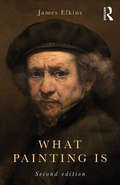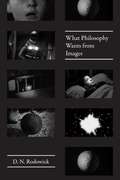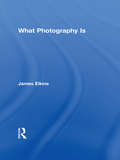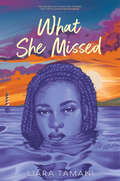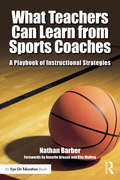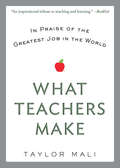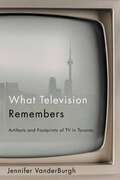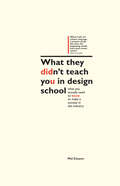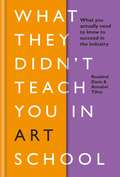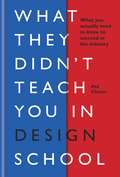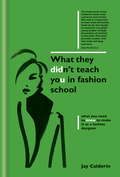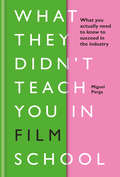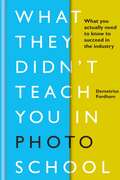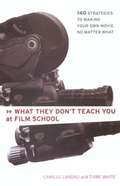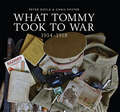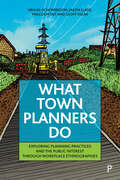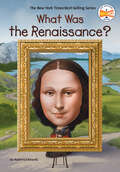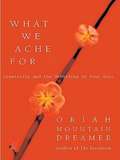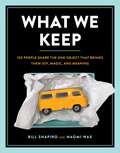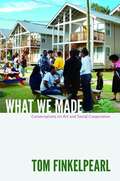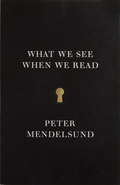- Table View
- List View
What Painting Is: How to Think about Oil Painting Using the Language of Alchemy
by James ElkinsIn this classic text, James Elkins communicates the experience of painting beyond the traditional vocabulary of art history. Alchemy provides a strange language to explore what it is a painter really does in the studio—the smells, the mess, the struggle to control the uncontrollable, the special knowledge only painters hold of how colors will mix, and how they will look. Written from the perspective of a painter-turned-art historian, this anniversary edition includes a new introduction and preface by Elkins in which he further reflects on the experience of painting and its role in the study of art today.
What Philosophy Wants from Images
by D. N. RodowickIn recent decades, contemporary art has displayed an ever increasing and complicated fascination with the cinema—or, perhaps more accurately, as D. N. Rodowick shows, a certain memory of cinema. Contemporary works of film, video, and moving image installation mine a vast and virtual archive of cultural experience through elliptical and discontinuous fragments of remembered images, even as the lived experience of film and photography recedes into the past, supplanted by the digital. Rodowick here explores work by artists such as Ken Jacobs, Ernie Gehr, Victor Burgin, Harun Farocki, and others—artists who are creating forms that express a new historical consciousness of images. These forms acknowledge a complex relationship to the disappearing past even as they point toward new media that will challenge viewers’ confidence in what the images they see are or are becoming. What philosophy wants from images, Rodowick shows, is to renew itself conceptually through deep engagement with new forms of aesthetic experience.
What Photography Is
by James ElkinsIn What Photography Is, James Elkins examines the strange and alluring power of photography in the same provocative and evocative manner as he explored oil painting in his best-selling What Painting Is. In the course of an extended imaginary dialogue with Roland Barthes's Camera Lucida, Elkins argues that photography is also about meaninglessness--its apparently endless capacity to show us things that we do not want or need to see--and also about pain, because extremely powerful images can sear permanently into our consciousness. Extensively illustrated with a surprising range of images, the book demonstrates that what makes photography uniquely powerful is its ability to express the difficulty--physical, psychological, emotional, and aesthetic--of the act of seeing.
What Remains: The Suitcases of Charles F. at Willard State Hospital (Excelsior Editions)
by Ilan Stavans Jon CrispinAfter the closure of Willard Psychiatric Center on New York's Seneca Lake in 1995, more than four hundred abandoned suitcases were discovered in its attic, containing thousands of personal possessions belonging to former patients. Three of the suitcases were owned by Charles F., an eighty-four-year-old Russian Jewish immigrant arrested at a Brooklyn subway station in 1946 and institutionalized at Willard State Hospital (as it was then known).An extraordinary collaboration between image and text, What Remains pairs Jon Crispin's gripping photographs of Charles's belongings with Ilan Stavans's intriguing, speculative portrait of a patient and institution at odds with one another. Anxious, isolated, and senile, Charles strikes an unexpected friendship with a young doctor whose empathy accompanies him through a sudden spiritual awakening. As the narrative unfolds, it becomes clear that Stavans, himself an immigrant from Mexico whose family history is marked by bouts of mental illness, approaches his character as a surrogate of his own personal journey. Crispin's photographs of Charles's possessions—including clothing, household tools, and Jewish ritual objects—are haunting in their ability to compel the reader to imagine a distant man's life. A moving blend of fact and fiction, photography and prose, What Remains reflects on questions of mental health, spirituality, and the Jewish immigrant experience in midcentury America.
What She Missed
by Liara TamaniSixteen-year-old Ebony Jones is devastated when her family moves from Houston to her grandmother’s house in the country. There’s absolutely nothing for Ebony in Alula Lake, Texas. So she thinks.Award-winning author Liara Tamani’s What She Missed is a rich and emotional novel that celebrates change, nature, friendship, growing up, and love, for readers of Sarah Dessen’s The Rest of the Story and Elizabeth Acevedo’s Clap When You Land. When Ebony and her parents move from Houston, Texas, to her grandmother’s house in a small lake town, Ebony is sure her life is doomed. And to make matters worse, the ghost of Ebony’s beloved grandmother—a strong swimmer who tragically drowned in the lake—is everywhere. Alula Lake does offer one perk: reconnecting Ebony with her childhood friend, Jalen.But as Ebony settles into life, she finds herself drifting away from Jalen and gravitating to his older sister, Lena. Lena is chaotic, disorderly, and rebellious, yet she offers a reprieve for the anger and sadness Ebony feels about losing so much.An ode to nature, art, friendship, history, family, and love, this lyrical coming-of-age story explores one girl’s summer of self-discovery as she reimagines the world and her place in it. What She Missed is for fans of Sarah Dessen, Nina LaCour, and Nicola Yoon.
What Student Architects Should Do (Analysing Architecture Notebooks)
by Simon UnwinAs a first year student the challenges of learning how to do architecture can be daunting. Though not prescribing a particular way (there are as many ways to do architecture as there are architects), this Notebook outlines what you should do to cultivate your own distinctive capacity for architectural design.Architecture is a rich and varied subject, a multifaceted and multidimensional skill. Learning to do it is not easy. It has many subtleties. Becoming fluent can take many years. Informed by decades of discussing architecture and its challenges with students, this Notebook will help you lay foundations for a rewarding career as a creative architect.All Simon Unwin’s books explore architecture not just as a matter of form and space but in terms of its primal driving force, the universal need and desire to make places for life.Each of these Analysing Architecture Notebooks is devoted to a particular theme in understanding the rich and varied workings of architecture. They can be thought of as addenda to the foundation volume Analysing Architecture: the Universal Language of Place-Making, which first appeared in 1997 and has subsequently been enlarged in four further editions. Examining these extra themes as a series of Notebooks, rather than as additional chapters in future editions, allows greater space for more detailed exploration of a wider variety of examples, whilst avoiding the risk of the original book becoming unwieldy.
What Teachers Can Learn From Sports Coaches: A Playbook of Instructional Strategies
by Nathan BarberThe strategies used by winning coaches on the field can bring success to classrooms, too! In What Teachers Can Learn From Sports Coaches, you’ll uncover that the athletic arena and the classroom have more in common than you think. Author Nathan Barber demonstrates how many of the principles of coaching can be used by teachers to motivate students, build community, and enhance teaching. You’ll learn valuable lessons on… Communicating effectively Harnessing the power of teamwork Making work meaningful Embracing technology Building a winning tradition Teaching life lessons Seeking continual improvement And more! The book is filled with insightful quotes from well-known coaches, along with suggestions on how to apply the ideas to your own classroom. You’ll come away with strategies that you can use immediately to bring success to your own team—your students!
What Teachers Make
by Taylor MaliIn praise of the greatest job in the world... The right book at the right time: an impassioned defense of teachers and why we need them now more than ever. Teacher turned teacher's advocate Taylor Mali inspired millions with his original poem "What Teachers Make," a passionate and unforgettable response to a rich man at a dinner party who sneeringly asked him what teachers make. Mali's sharp, funny, perceptive look at life in the classroom pays tribute to the joys of teaching...and explains why teachers are so vital to our society. What Teachers Make is a book that will be treasured and shared by every teacher in America--and everybody who's ever loved or learned from one.
What Television Remembers: Artifacts and Footprints of TV in Toronto
by Jennifer VanderBurghTelevision in Canada has been undervalued as a cultural form. Despite being publicly funded, Canadian television programs are also notoriously difficult to access once they go off the air, which has compounded the problem.In What Television Remembers Jennifer VanderBurgh intervenes in the story of the medium in Canada by exploring the long relationship between TV and the city of Toronto. From the first demonstration of television at the Canadian National Exhibition in 1939 and the mass viewing of Queen Elizabeth II’s coronation broadcast in 1953 to the late-century installation of TV screens in public spaces around the city, television has shaped Toronto’s collective imagination and affirmed viewers in their multiple identities as local residents, national citizens, and transnational consumers. In a close reading of Toronto-based CBC dramas from the 1960s to 2010, VanderBurgh explains how the city has functioned as a strategic location in CBC programming, reflecting dramatically changing ideas about Canadian identity, community, and citizenship.At a time when many are suggesting that the era of television is over, What Television Remembers sounds the alarm that we are in danger of forgetting TV in Canada without appreciating the complexities of its contributions and legacy.
What They Didn't Teach You In Design School: What You Actually Need to Know to Make a Success in the Industry
by Phil CleaverYou'll appreciate this design career guide if:You're a recent graduate and looking for a job as a designer. You want resume and interviewing advice, as well as tips for working in the design industry. You'd like to learn how to avoid common pitfalls of asserting yourself in the design industry. <P><P>What They Didn't Teach You in Design School by Phil Cleaver provides advice on the stage from graduating, and getting into a studio and staying there as a valued designer, and explores best design practices. Though predominantly serving as a useful guide and bridge in the first year of your career as a designer, it should also be considered an essential tool that can be consulted when you're unsure of what to do next. Begin with the essentials of beginning your design career, like building your resume and portfolio, seeking out opportunities, and preparing for and securing interviews.More than just helping you get a job, however, this career guide serves to help you succeed in whichever design position you land. Learn how to effectively work with other designers and your own clients, keep up to date with the industry, hone your business skills, and much more. <P>From the day after graduation to the completion of your first year as a design professional, this career guide will help you stay on top of your game.In What They Didn't Teach You in Design School you'll find:11 chapters covering topics ranging from software skills, print production, and designer relations, to good design practice, web skills, and working with external suppliers. Helpful design advice that you'll want to return to again and againA word from the author:"Working in a studio is hugely different from studying; this book is aimed at helping you through the transition and giving you the ammo to climb this massive new learning curve." --Phil Cleaver
What They Didn't Teach You in Art School: What you need to know to survive as an artist (What They Didn't Teach You In School #3)
by Rosalind Davis Annabel TilleyYou have the artistic talent, but do you know how to make a success of it? The thing they don't teach you in art school is just how active and engaged you need to be; you'll have to become your own finance, business and marketing manager, as well as a researcher, curator and administrator. What They Didn't Teach You in Art School is the ultimate survival guide to life as an artist, and the perfect springboard for aspiring artists who haven't yet given up the day job. The book provides expert advice, tips and inspiration to help you build a successful career - giving you the opportunity to nurture your true talent.
What They Didn't Teach You in Design School: What you actually need to know to make a success in the industry (What They Didn't Teach You In School #1)
by Phil CleaverWith record numbers of design and advertising students graduating into the job market each year, it makes more sense now than ever before to be fully armed to succeed.This book helps new designers make the transition from design school to work, giving them the ammunition they need for a successful start.Here the reader will learn how to get that all-important first job, and how to impress their new employer. They will also have at their fingertips plenty of useful, practical information, essential to know in the design studio and when working for clients. Enriched with quotes and advice from some of the best and brightest in the industry, this book is where you will find out what they didn't teach you in design school.
What They Didn't Teach You in Fashion School (What They Didn't Teach You In School #4)
by Jay CalderinA career guide for fashion designers and professionals, covering everything you need to know about building a successful business after graduating.How do you navigate the confusing and competitive fashion world after the relative comfort of fashion school? How do you learn to adapt to an industry that constantly evolves and throws new challenges your way? And above all, how do you play to your strengths as a designer, and build a successful career in business.What They Didn't Teach You in Fashion School is your survival guide to the fashion industry. Providing expert advice, and lots of inspiration, Jay Calderin shows you how to make a brilliant career in the exhilarating world of fashion.
What They Didn't Teach You in Fashion School (What They Didn't Teach You In School Ser.)
by Jay CalderinA career guide for fashion designers and professionals, covering everything you need to know about building a successful business after graduating.How do you navigate the confusing and competitive fashion world after the relative comfort of fashion school? How do you learn to adapt to an industry that constantly evolves and throws new challenges your way? And above all, how do you play to your strengths as a designer, and build a successful career in business.What They Didn't Teach You in Fashion School is your survival guide to the fashion industry. Providing expert advice, and lots of inspiration, Jay Calderin shows you how to make a brilliant career in the exhilarating world of fashion.
What They Didn't Teach You in Film School
by Miguel PargaIn the cut-throat world of the film industry, you need every advantage you can get to rise above the competition and make a name for yourself. This essential guide combines a practical, no-nonsense approach with a lifetime of insider knowledge, giving you the competitive edge to jump-start your career.Packed with hard-working tips and advice, this book shows you how to get the best out of your film-school education, how to navigate some of the most frustrating moments in an artist's life, and how to keep the inspiration going as you battle your way through the filmmaking world.
What They Didn't Teach You in Film School
by Miguel PargaIn the cut-throat world of the film industry, you need every advantage you can get to rise above the competition and make a name for yourself. This essential guide combines a practical, no-nonsense approach with a lifetime of insider knowledge, giving you the competitive edge to jump-start your career.Packed with hard-working tips and advice, this book shows you how to get the best out of your film-school education, how to navigate some of the most frustrating moments in an artist's life, and how to keep the inspiration going as you battle your way through the filmmaking world.
What They Didn't Teach You in Photo School: What you actually need to know to succeed in the industry (What They Didn't Teach You In School #2)
by Demetrius FordhamThis book won't tell you how to take photographs. It will, though, teach you a much more difficult set of skills: how to be a photographer.Passing on hard-earned lessons from a successful career in commercial, editorial and lifestyle photography, Demetrius Fordham shows how to snag the best internships and assistant roles, impress at an interview, develop an amazing portfolio, forge strong relationships with clients, and lay the foundations of your own successful career. Illustrated throughout with Demetrius' own duotone photography, dramatically typeset to appeal to visual thinkers, and presented in an appealing handbook format, this is the book that will launch the careers of the next generation of photographers.
What They Don't Teach You at Film School: 161 Strategies For Making Your Own Movie No Matter What
by Camille Landau Tiara White<p>Two filmmakers who've beaten the system give the real dope on what it takes to get your movie made. <p>Do you have to go to film school to get your movies made? No, say two young entrepreneurs who survived the grind. Here they offer 140 strategies for making movies no matter what. Amateurs as well as seasoned veterans can pick up this entertaining and incredibly useful guide in any place--at any point of crisis--and find tactics that work. Whether it's raising money or cutting your budget; dealing with angry landlords or angry cops; or jump-starting the production or stalling it while you finish the script, these strategies are delivered with funny, illustrative anecdotes from the authors' experiences and from veteran filmmakers eager to share their stories. Irreverent, invaluable, and a lot cheaper than a year's tuition, this friendly guide is the smartest investment any future filmmaker could make. <p>Strategies from the book include: Love your friends for criticizing your work--especially at the script stage; Shyness won't get you the donuts; Duct tape miracles; Don't fall in love with cast or crew (but if you do...).
What Tommy Took to War: 1914-1918
by Peter DoyleA century may now have passed since the Great War, but the stories of everyday soldiers serving in miserable and life-threatening conditions still have a sobering sense of immediacy. Personal records, photographs and sentimental possessions that bring us even closer to the soldier as a person have often become valuable heirlooms, passed down through the generations. Nothing better depicts an individual soldier than these items, which were kept about his person and in his kitbag, and which constituted all his worldly possessions while on service in the trenches. This book looks at fifty objects with which every Tommy would have been familiar, from official uniform and equipment to good-luck charms and letters from sweethearts. With each artifact – be it an identity disc, training manual, packet of cigarettes, postcard or foreign phrasebook – the accompanying text explains the significance of all the things that, together, help to define him both as a man and as a soldier.
What Town Planners Do: Exploring Planning Practices and the Public Interest through Workplace Ethnographies
by Geoff Vigar Abigail Schoneboom Jason Slade Malcolm TaitPresenting the complexities of doing planning work, with all its attendant moral and practical dilemmas, this rich ethnographic study analyses how places are made through stories of four diverse public and private sector working environments. The book provides a unique insight for educators, students and researchers into the everyday lives of planners and those in associated built environment occupations. This exceptional account of the micro-politics of a knowledge-intensive profession also provides an excellent resource for sociologists of contemporary work. The authors use team ethnography to push the methodological frontiers of planning research and to advance organisational ethnography into new areas.
What Was the Renaissance? (What Was?)
by Who HQ Roberta EdwardsDiscover all there is to know about the Renaissance, the period in history that took Europe from the Middle Ages to modern times!Beginning in Italy, the Renaissance was a cultural movement that spread throughout Europe and affected art, science, technology, politics, and thought. From the 1300s to the beginning of the 1600s, scholars started to question what they knew and looked to literature and historical texts to develop new ideas for why things were the way they were. In just a short amount of time, the foundations for European life were uprooted and examined, leading people, including Leonardo da Vinci and Michelangelo, to explore new ways of thinking and being. Readers will learn why the Renaissance was such a pivotal time in European history and how it still influences us.
What We Ache For: Creativity and the Unfolding of Your Soul
by Oriah Mountain DreamerInspirational guide to awakening personal creativity in any art form. Dreamer uses practical examples to convey the link between creativity, spirituality, and sexuality while showing how all 3 can enrich one's life.
What We Keep: 150 People Share the One Object that Brings Them Joy, Magic, and Meaning
by Bill Shapiro Naomi WaxWith contributions from Cheryl Strayed, Mark Cuban, Ta-Nahesi Coates, Melinda Gates, Joss Whedon, James Patterson, and many more--this fascinating collection gives us a peek into 150 personal treasures and the secret histories behind them. All of us have that one object that holds deep meaning--something that speaks to our past, that carries a remarkable story. Bestselling author Bill Shapiro collected this sweeping range of stories--he talked to everyone from renowned writers to Shark Tank hosts, from blackjack dealers to teachers, truckers, and nuns, even a reformed counterfeiter--to reveal the often hidden, always surprising lives of objects.
What We Made: Conversations on Art and Social Cooperation
by Tom FinkelpearlIn What We Made, Tom Finkelpearl examines the activist, participatory, coauthored aesthetic experiences being created in contemporary art. He suggests social cooperation as a meaningful way to think about this work and provides a framework for understanding its emergence and acceptance. In a series of fifteen conversations, artists comment on their experiences working cooperatively, joined at times by colleagues from related fields, including social policy, architecture, art history, urban planning, and new media. Issues discussed include the experiences of working in public and of working with museums and libraries, opportunities for social change, the lines between education and art, spirituality, collaborative opportunities made available by new media, and the elusive criteria for evaluating cooperative art. Finkelpearl engages the art historians Grant Kester and Claire Bishop in conversation on the challenges of writing critically about this work and the aesthetic status of the dialogical encounter. He also interviews the often overlooked co-creators of cooperative art, "expert participants" who have worked with artists. In his conclusion, Finkelpearl argues that pragmatism offers a useful critical platform for understanding the experiential nature of social cooperation, and he brings pragmatism to bear in a discussion of Houston's Project Row Houses. Interviewees. Naomi Beckwith, Claire Bishop, Tania Bruguera, Brett Cook, Teddy Cruz, Jay Dykeman, Wendy Ewald, Sondra Farganis, Harrell Fletcher, David Henry, Gregg Horowitz, Grant Kester, Mierle Laderman Ukeles, Pedro Lasch, Rick Lowe, Daniel Martinez, Lee Mingwei, Jonah Peretti, Ernesto Pujol, Evan Roth, Ethan Seltzer, and Mark Stern
What We See When We Read
by Peter MendelsundA gorgeously unique, fully illustrated exploration into the phenomenology of reading--how we visualize images from reading works of literature, from one of our very best book jacket designers, himself a passionate reader. What do we see when we read? Did Tolstoy really describe Anna Karenina? Did Melville ever really tell us what, exactly, Ishmael looked like? The collection of fragmented images on a page--a graceful ear there, a stray curl, a hat positioned just so--and other clues and signifiers helps us to create an image of a character. But in fact our sense that we know a character intimately has little to do with our ability to concretely picture our beloved--or reviled--literary figures. In this remarkable work of nonfiction, Knopf's Associate Art Director Peter Mendelsund combines his profession, as an award-winning designer; his first career, as a classically trained pianist; and his first love, literature--he considers himself first and foremost as a reader--into what is sure to be one of the most provocative and unusual investigations into how we understand the act of reading.
